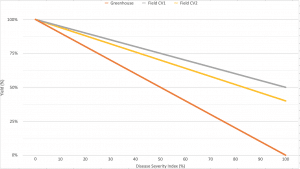Growers and agronomists can estimate canola yield loss from clubroot with a disease severity index (DSI) measurement eight weeks after seeding the crop.
Andrea Botero-Ramírez tested a yield loss formula while a PhD student in Stephen Strelkov’s lab at the University of Alberta. Botero-Ramírez scouted canola fields eight weeks after seeding and evaluated roots for clubroot severity using a 0 to 3 scale:
- 0 = no galling
- 1 = few small galls (small galls on less than one-third of the roots),
- 2 = moderate galling (small to medium galls in one-third to two-thirds of the roots)
- 3 = severe galling (medium to large galls in more than two-thirds of the roots).
Botero-Ramírez plugged field ratings into the following formula, developed by Horiuchi and Hori (1980) and modified by Strelkov et al. (2006).

Botero-Ramírez’s field results suggest 0.6 per cent yield loss for every one per cent DSI. For example, if DSI if 50 using the scouting-based formula, field yield loss could be 30 per cent. Under severe conditions (high disease loads and ideal growing conditions) the yield loss may be even greater.
Research behind the estimates
This estimates are based on Botero-Ramírez research, which measured canola yield loss from clubroot in greenhouse and field experiments. In the greenhouse, yield declined by 0.9 to one per cent for each one per cent increase in the clubroot disease severity index (DSI). Greenhouse results indicate the potential of clubroot to reduce yield. Field results were less severe.
In field experiments, canola yield declined between 0.54 and 0.62 per cent for each one per cent increase in DSI. Differences within that range depended on the cultivar tested. Field studies are more variable because soil spore levels are more variable. In the field study, P. brassicae inoculum loads in the soil varied from low to moderately high (zero to 100,000,000 spores/gram of soil), which is typical for most infested fields dealing with clubroot. Together, these studies can represent the range in which clubroot can steal yield.
Botero-Ramírez settled on 0.6 as a simple start point for estimates.

